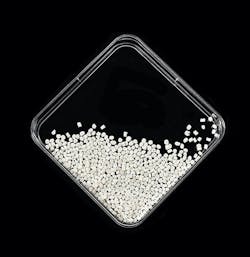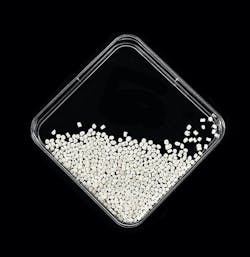Degradable Polymer Rivals Polypropylene
Figure 1. New process allows industrial-scale production of polyhydroxybutyrate. Source: Fraunhofer IPK/Andy King.
A biopolymer produced from industrial leftovers such as waste fats offers properties very similar to those of polypropylene (PP), report researchers in Germany. However, unlike PP, the polymer — polyhydroxybutyrate (PHB) — fully degrades in 6-12 months, they add. Moreover, a new process enables production of PHB on an industrial scale, say its developers at the Fraunhofer Institute for Production Systems and Design Technology (IPK), Berlin.The researchers used a genetically modified version of the bacterium Ralstonia eutropha to metabolize waste residues into PHB. They carried out the process in 1,000-L fermentation tanks kept at 30°C, pH 6.8 and with a dissolved oxygen concentration exceeding 40%.
The team has tested a number of PHB purification steps on the dried cell mass post-fermentation. These include using mealworms, mechanical purification via high pressure homogenization, and purely chemical purification.
“Although various approaches are conceivable and already tested, for production for research purposes we use chemical purification. However, the solvents can be completely recovered and do not burden the ecological balance,” notes Christoph Hein, head of the department of microproduction technology at the IPK.
The only waste materials produced are humus, water and carbon dioxide.
“However, once the plastic has been dissolved from the cell, it is still not ready for industrial use because the hardening process takes far too long,” he adds.
To counter this, the raw material requires mixing with chemical additives downstream in post-production stages. For example, the research team adjusted the plasticizing and processing parameters to trim the recrystallization time to fit the timing of industrial processing. The team also is testing new injection and micro-injection molding processes that they have developed in-house.
The result is the creation of a novel family of materials that satisfy the demands of technical plastics, the researchers claim.
“The new family of materials results from the integration of an HHx chain into the polymer, so that the elastic material properties are significantly improved compared to pure polyhydroxyalkanoates (PHAs) — a group of bioplastics that have a wide range of applications,” explains Hein.
The researchers now are focusing on scaling up fermentation production capacity to the metric ton/month range, further developing additive manufacturing processes, and testing the new materials in primary applications. An industrial consortium involved in the work is carrying out the testing; the identities of the companies involved remain confidential.

